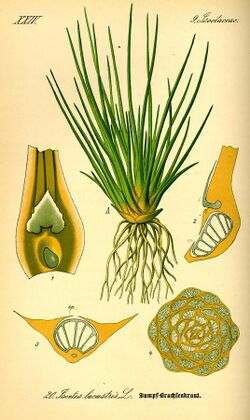Biology:Isoetales
| Isoetales | |
|---|---|

| |
| Isoetes | |

| |
| Pleuromeia | |
| Scientific classification | |
| Kingdom: | Plantae |
| Clade: | Tracheophytes |
| Clade: | Lycophytes |
| Class: | Lycopodiopsida |
| Order: | Isoetales Prantl |
| Families | |
|
Chaloneriaceae† | |
Isoetales, sometimes also written Isoëtales, is an order of plants in the class Lycopodiopsida.
There are about 140-150 living species, all of which are classified in the genus Isoetes (quillworts), with a cosmopolitan distribution, but often scarce to rare. Living species are mostly aquatic or semi-aquatic, and are found in clear ponds and slowly moving streams. Each leaf is slender and broadens downward to a swollen base up to 5 mm wide where the leaves attach in clusters to a bulb-like, underground corm characteristic of most quillworts. This swollen base also contains male and female sporangia, protected by a thin, transparent covering (velum), which is used diagnostically to help identify quillwort species. Quillwort species are very difficult to distinguish by general appearance. The best way to identify them is by examining the megaspores under a microscope.
Isoetes are the only living pteridophytes capable of secondary growth.[1]
Fossils
Some authors include the tree-like "aboresecent lycophytes", which formed forests during the Carboniferous period, and often assigned to their own order, Lepidodendrales, within Isoetales.[2]
Fossilised specimens of Isoetes beestonii have been found in rocks dating to the latest Permian-earliest Triassic.[3][4] During the Early Triassic, Isoetales, such as the long-stemmed Pleuromeia were dominant over large areas of the globe.[5] The oldest fossil closely resembling modern quillworts is Isoetites rolandii from the Late Jurassic of North America.[6]
References
- ↑ Karrfalt, Eric E. (1982-12-01). "Secondary Development in the Cortex of Isoetes". Botanical Gazette 143 (4): 439–445. doi:10.1086/337319. ISSN 0006-8071. https://www.journals.uchicago.edu/doi/10.1086/337319.
- ↑ Bateman, Richard M.; DiMichele, William A. (October 2021). "Escaping the voluntary constraints of "tyre-track" taxonomy" (in en). Taxon 70 (5): 1062–1077. doi:10.1002/tax.12540. ISSN 0040-0262. https://onlinelibrary.wiley.com/doi/10.1002/tax.12540.
- ↑ Retallack, Gregory J. (1997). "Earliest Triassic origin of Isoetes and quillwort evolutionary radiation". Journal of Paleontology 7 (3): 500–521. doi:10.1017/S0022336000039524. Bibcode: 1997JPal...71..500R.
- ↑ Retallack, Gregory J. (2013). "Permian and Triassic greenhouse crises". Gondwana Research 24 (1): 90–103. doi:10.1016/j.gr.2012.03.003. Bibcode: 2013GondR..24...90R.
- ↑ Looy, Cindy V.; van Konijnenburg-van Cittert, Johanna H. A.; Duijnstee, Ivo A. P. (2021). "Proliferation of Isoëtalean Lycophytes During the Permo-Triassic Biotic Crises: A Proxy for the State of the Terrestrial Biosphere". Frontiers in Earth Science 9: 55. doi:10.3389/feart.2021.615370. ISSN 2296-6463. Bibcode: 2021FrEaS...9...55L.
- ↑ Wood, Daniel; Besnard, Guillaume; Beerling, David J.; Osborne, Colin P.; Christin, Pascal-Antoine (2020-06-18). Wong, William Oki. ed. "Phylogenomics indicates the "living fossil" Isoetes diversified in the Cenozoic" (in en). PLOS ONE 15 (6): e0227525. doi:10.1371/journal.pone.0227525. ISSN 1932-6203. PMID 32555586. Bibcode: 2020PLoSO..1527525W.
External links
- World list of all species in order Isoetales from World Ferns by M. Hassler in the Catalogue of Life, 203 species.
Wikidata ☰ Q7170041 entry
 |

